

LearnEnglish Parents - British Council - Home. Find a course. Download the apps. Watch the Learning Time with Timmy video series. Find a course. Learning Time with Timmy. Primary Plus – English for kids aged 6-12. During the Covid-19 pandemic many of our teaching centres are closed. Primary Plus – English for kids aged 6-12. LearnEnglish Kids.
Moodle. Moodle. Moodle. Moodle. English for the Workplace. Exploring English: Shakespeare. TeachingEnglish. Short courses on FutureLearn. Online courses from British Council. To Help Children Learn, Build on What They Already Know - RAISE READY KIDS. In his brilliant children’s book Fish Is Fish, Leo Lionni tells the story of a fish and tadpole who become best friends.
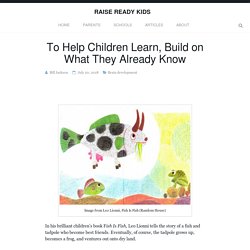
Eventually, of course, the tadpole grows up, becomes a frog, and ventures out onto dry land. One day, the frog jumps back into the pond to see his old friend the fish. “I have seen extraordinary things!” The frog exclaims. “Like what?” The frog tells his fish friend about birds, cows, and people. Of course! Maybe the earth is shaped like a pancake…
Let’s lose the ADHD label and find the child. When I trained as a primary school teacher 15 years ago, these were some of the words used to describe children with ADHD: ‘Difficult.’

‘Challenging.’ ‘Disruptive.’ There were others, whispered by harassed-looking teachers in the staffroom or concerned parents at the school gates, but none seemed to be positive. When I got my first ‘real’ class to teach, and saw that some of the children came with the dreaded ‘ADHD’ label attached, I approached the new term with butterflies the size of dragons in my stomach. Pre-birth to Three: Observation, Assessment and Planning. Information_sheet_-_Guidelines_for_documenting_children_s_learning. Early Learning for Every Child Today. A framework for Ontario early childhood settings.
Observation, Assessment and Planning - Early Years Matters. The EYFS Profile summarises and describes children’s attainment at the end of the EYFS.
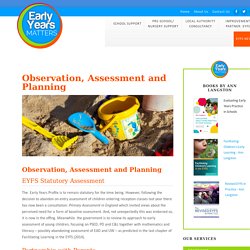
It is based on on-going observation and assessment in the three prime and four specific areas of learning, and the three learning characteristics, set out below: The prime areas of learning: Assessment for Learning – Education in New Zealand. Development-Matters-FINAL-PRINT-AMENDED.
How Are Happiness and Learning Connected? As teachers, we also know that when students' affective filters or defenses are sky high, fight or flight responses will be modus operandi. A room full of defensive behaviors (withdrawn, angry) is a sad, unproductive place to teach and learn. Key Person & Attachment - Early Years Matters.
The Key Person.

NQS_PLP_E-Newsletter_No36. EducatorsEn. Background_to_the_Concept_of_Schema. Positive Learning Environment - Primary. HowLearningHappens. KQED Public Media for Northern CA. To make that argument requires a deep dive into the profound nature of empathy.
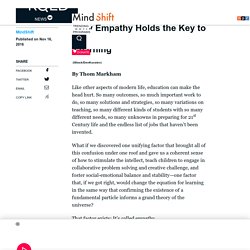
Right now, empathy roughly equates to “I like you and am willing to tolerate you regardless of differences because I am a good person.” But the textbook definition hints at something more profound: It’s ‘the feeling of being able to understand and share another person’s experiences and emotions.’ That all-encompassing definition means empathy results from a complex mix of other meaningful emotions and attitudes that fuel human personality, such as openness, curiosity, self-restraint, vulnerability, sensitivity, awareness, respect, appreciation, and even love. Add this list to the fact that empathy can’t manifest unless we have had our own experiences and emotions to contrast, compare, and connect with others—and we can see that empathy is more than a simple connector; it’s the subterranean, fundamental glue that holds humanity together. The takeaway? A 19-Year Study Reveals Kindergarten Students With These 2 Skills Are Twice as Likely to Obtain a College Degree (and They Have Nothing to Do With Reading)
KQED Public Media for Northern CA. Babies and toddlers raised in supportive and caring home environments tended to do better on standardized tests later on, and they were more likely to attain higher degrees as adults.

They were also more likely to get along with their peers and feel satisfied in their romantic relationships. "It seems like, at least in these early years, the parents' role is to communicate with the child and let them know, 'I'm here for you when you're upset, when you need me. And when you don't need me, I'm your cheerleader,' " says Lee Raby, a psychologist and postdoctoral researcher at the University of Delaware who led the study. Raby used data collected from 243 people who participated in the Minnesota Longitudinal Study of Risk. All the participants were followed from birth until they turned 32. Of course, parental behavior in the early years is just one of many influences, and it's not necessarily causing the benefits seen in the study.
Can Free Play Prevent Depression and Anxiety In Kids? Don't Expect Toddlers To Behave Consistently — They Literally Can't. One day, when my oldest daughter was not quite 2, she wouldn’t sit still to let me change her diaper. Squirrelly and writhing, she made a game out of staying half naked. She wasn’t fussing about it or anything — in fact, she was giggling maniacally. The problem was that we were running late. Nothing I did seemed to faze her. One theory all teachers with disruptive children should know about. Imagine a classroom where children are unable to wait their turn or stay focused on their work.
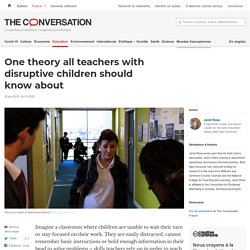
They are easily distracted, cannot remember basic instructions or hold enough information in their head to solve problems – skills teachers rely on in order to teach successfully. These behavioural issues are all examples of problems that can arise from attachment issues – based on the relationship between children and their main caregiver. Attachment theory is now one of the world’s most well-researched theories about human development.
It was first proposed by the 20th-century British psychiatrist John Bowlby, who considered that children needed to develop a secure attachment with their main caregiver via sufficiently consistent, responsive, sensitive, appropriate and predictable care and support. The Key to Effective Classroom Management. It’s a daunting but all-too-common sight for many teachers: A classroom full of rowdy students who are unable to focus on the lesson. Classroom management techniques may get things back on track, but valuable time has already been lost. Many experienced teachers know that making meaningful connections with students is one of the most effective ways to prevent disruptions in the first place, and a new study set out to assess this approach.
In classrooms where teachers used a series of techniques centered around establishing, maintaining, and restoring relationships, academic engagement increased by 33 percent and disruptive behavior decreased by 75 percent—making the time students spent in the classroom more worthwhile and productive. “Strong teacher-student relationships have long been considered a foundational aspect of a positive school experience,” explains Clayton Cook, the lead author of the study and a professor at the University of Minnesota. Relationship reflection form. 21 of the Best Early Years Books for International Friendship Day. We know that skills like empathy aren’t fully developed until later in a child’s life, which is why there are so many stories on friendship and how to treat people aimed at Early Years.
International Friendship Day, then, is a great opportunity to share some of these amazing books with your children. It does, however, fall on Sunday 30 July. So celebrating on the day itself is going to be difficult, doubly so for Reception classes who are on summer holidays. This ‘Kindness Curriculum’ Is Free And Should Be Used In Every Classroom. Imagine living in a world that valued kindness enough to teach it along with academics. Educators would teach kids to manage their emotions in addition to standard curriculum such as math and science. Sounds pretty amazing, doesn’t it? Well, the Center for Healthy Minds at the University of Wisconsin-Madison has created a free “kindness curriculum” for kids, designed to do just that.
It’s a mindfulness-based curriculum for preschoolers that will bring kindness into the classroom. 2Bbellybreathhome. Moodle. Providing resources and opportunities. Primary Plus – English for kids aged 6-12. Does my toddler have a short attention span because she won’t sit still for a story? A: It is perfectly normal for toddlers to not sit still very long—period.
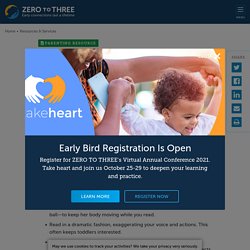
Most don’t like to stay in one place for long now that they can explore in so many new ways—by running, jumping, and climbing. So, an adult’s idea of snuggling on the couch to hear a story may not be the same idea a toddler has for story-time. You may only be able to read or talk about a few pages in a book at a time. Here are some ways to engage active children in reading: "I Said I Want the Red Bowl!" Responding to… Amelia, told that she can’t have a fifth book before bedtime, shouts: “You are the meanest mommy!
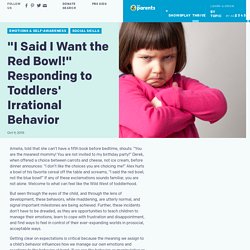
You are not invited to my birthday party!” Derek, when offered a choice between carrots and cheese, not ice cream, before dinner announces: “I don’t like the choices you are choicing me!” Alex hurls a bowl of his favorite cereal off the table and screams, “I said the red bowl, not the blue bowl!” If any of these exclamations sounds familiar, you are not alone. Welcome to what can feel like the Wild West of toddlerhood. But seen through the eyes of the child, and through the lens of development, these behaviors, while maddening, are utterly normal, and signal important milestones are being achieved. Schemas in Children’s Play - N a t u r e P l a y. Let’s lose the ADHD label and find the child. Early Literacy. Making their mark children's early writing. Guiding Principles for Use of Technology with Early Learners. The thoughtful use of technology by parents and early educators can engage children in key skills such as play, self-expression, and computational thinking which will support later success across all academic disciplines and help maintain young children’s natural curiosity.
Watch the Learning Time with Timmy video series. Download the apps. Find a course. Practical tips. By Opal Dunn, educational consultant and author Introduction Young children learn English differently from most adults.

Learning Time with Timmy. How to help your child learn English with YouTube videos. Tracey Chapelton, education consultant and materials writer, has some advice for parents of young English learners, whose home language might not be English. The Art of Control. Executive function — our ability to remember and use what we know, defeat our unproductive impulses, and switch gears and adjust to new demands — is increasingly understood as a key element not just of learning but of lifelong success. Researchers at the Center on the Developing Child at Harvard University describe executive function as an air traffic control system for the mind — helping us manage streams of information, revise plans, stay organized, filter out distractions, cope with stress, and make healthy decisions.
Children learn these skills first from their parents, through reliable routines, meaningful and responsive interactions, and play that focuses attention and stirs the beginnings of self-control. Ey_making_mark_matters76708_1_ Nihms175063. Children-under-5-years. Children-under-5-walking. How to teach children English using illustrated storybooks. What makes illustrated storybooks such a good resource for teaching young learners of English? The British Council’s Gail Ellis, co-author of a storytelling handbook for primary English language teachers, explains. Short stories for kids.
Songs for kids. 50+ Quick & Easy Kids Crafts that ANYONE Can Make! Music and Movement Activities for Toddlers and Preschoolers. Nursery Rhymes and Songs - BBC Teach. Poems for kids. Whole Child Development Is Undervalued. The question is how to make such an approach both systemic and sustainable. Whole Person. Making their mark children's early writing. Ten ways to support your child’s English-learning at home. Learning_through_play_ey.
Sound Words: Examples of Onomatopoeia. Onomatopoeia is a fun, linguistic tool used in literature, songs and advertisements. Now that you've seen examples of the individual words, consider the following examples of onomatopoeia words in use. Take a look at the different onomatopoeia examples in Todd Rundgren's song, appropriately named Onomatopoeia. MIT Brain Study: Back-And-Forth Talk Key To Developing Kids' Verbal Skills. Moodle. Moodle. Moodle. Moodle. Moodle. Serve and Return. Effective Teacher-Child Interactions. Quality Interactions Early Years. The Brain-Changing Power of Conversation.
NQS_PLP_E-Newsletter_No43. Carol Dweck: The power of believing that you can improve. How can parents and teachers best educate young children? Listening Skills for Staff. A longitudinal investigation of the role of quantity and quality of child-directed speech in vocabulary development.
Does my toddler have a short attention span because she won’t sit still for a story? "I Said I Want the Red Bowl!" Responding to… Schemas in Children’s Play - N a t u r e P l a y. Schema and Fairies. 2Bbellybreathhome. Teaching English to learners with Special Educational Needs (SENs) – Myths and realities. Neurodiversity TfS online conference. B480 Special Need Publication A4 V5 Final MR. FAQ: Raising Bilingual Children.